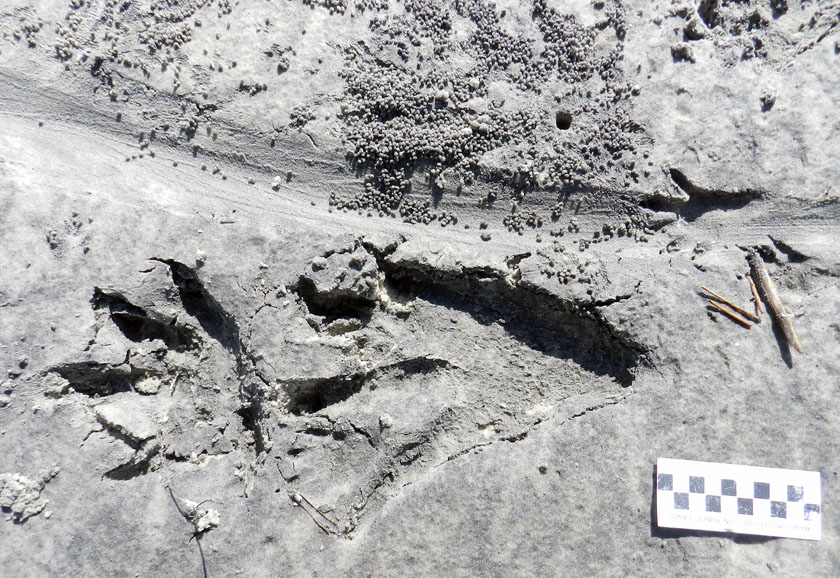Nearly anyone who enjoys writing or reading good science writing knows there are a few tricks of the trade used to interest readers and motivate them to go from one sentence to the next. One technique I’ve heard about – and have used in Life Traces of the Georgia Coast, as well as my upcoming book Dinosaurs Without Bones – is the “sensory” one.
In this method, the writer refers to stimuli that connect with one, several, or all of the human senses in the narrative. Sometimes the inclusion of more than one sense is tough to do in science writing, especially if the science is being conducted in a lab. Yet it works very well with reporting natural history in the field, in which the writer experiences sights, sounds, smells, touch, and sometimes even taste while outside, and in less controlled circumstances.
 Never mind the appearance of these alligator tracks and tail dragmark, and fiddler-crab burrows and feeding pellets. How do they sound?
Never mind the appearance of these alligator tracks and tail dragmark, and fiddler-crab burrows and feeding pellets. How do they sound?
I see writing as a continual exercise in which I will keep learning by doing it and honing it (with a recent instance of that here). My wife Ruth also recognizes this quality in me, and was thoughtful enough to give me a book related to this goal: Steering the Craft (1998) by famed author and poet Ursula Le Guin. What I love about this book is that Le Guin does not just dole out writing advice, but does it succinctly (thus leading by example), with good humor, and most importantly, puts theory into practice with writing exercises at the end of each chapter.
The first writing exercise dealt with sounds, and how language – even when written – should pay attention to it sounds. Here were her instructions:
BEING GORGEOUS: Write a paragraph to a page (150-300 words) or narrative that’s meant to be read aloud. Use onomatopoeia, alliteration, repetition, rhythmic effects, made-up words or names, dialect – any kind of sound-effect you like – but NOT rhyme or meter.
So just to make it easy on myself with this first writing assignment, I picked an ichnologically based example, and one I had blogged about just last month, Erasing the Tracks of a Monster. I originally wrote about this topic from the perspective as a field scientist reporting some very cool (to me) observations in the field, and didn’t really enrich the writing beyond that.
Thus for Le Guin’s exercise, the following came out of me, and it sure was was different from how i wrote about the same phenomena a few weeks before. In writing this, I asked myself: How do traces sound? So I hope you enjoy it, and if you did, read it aloud with gusto for maximum effect.
The Daily Terror
An alligator ambling along with ankles all akimbo
Plopping scaley feet on sloppy mud, then pulling them up
Moist resistance, a sucking sound that pops with each step.
Tail, big and keeled, flopping from one side to another
Dragging on its side, scraping along, swathing its way
Then hup-two, back up again, a ship righting itself on land.
Fiddler crabs scramble and scurry, getting out of his wake
A monster invader, Godzilla incarnate, legendary vengeance
Claws are waved, then tucked against carapaces, recoiling in fear.
Hiding in burrows, the thunder rumbles overhead on a ground
Trembling with the motion of the oblivious and massive reptilian
Locomotive with an unheeding mind, while mindless of their plights.
Homes are squashed, a few fiddlers too, destruction and chaos
However, quickly passes, and then slow, like molasses, they return
Burrowing, gathering, mating, breathing, exoskeletons dancing.
The TICKTACKULAR returns to their village each time the tide subsides
Its prowling rejecting their presence and bringing them no presents
Good thing for them that instinctual cowering is so ephemeral.
[Appreciative clicking of fingers from the audience, a clacking of jaws from the alligators present, and the quick staccato tapping of pointed feet from the fiddler crabs on the wooden floor.]
